In the 19th century, treasure hunters and amateur archaeologists made off with many of its most beautiful and important objects, some of which can now be seen in foreign museums.
In this century too, ancient objects from Sidon (Saidoon is the Phoenician name, Saida in Arabic), have turned up on the world's antiquities markets.
Other traces of its history lie beneath the concrete of modern constructions, perhaps buried forever.
The challenge for today's visitor to Sidon then is to recapture a sense of this city's ancient glory from the intriguing elements that still survive.
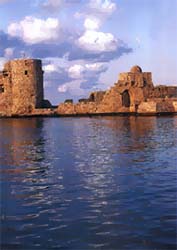
A
long
and
glorious
history
There
is
evidence
that
Sidon
was
inhabited
as
long
ago
as
4000
B.C.,
and
perhaps
as
early
as
Neolithic
times
(6000
-
4000
B.C.).
The
ancient
city
was
built
on
a
promontory
facing
an
island,
which
sheltered
its
fleet
from
storms
and
served
as
a
refuge
during
military
incursions
from
the
interior.
In
its
wealth,
commercial
initiative,
and
religious
significance,
Sidon
is
said
to
have
surpassed
all
other
Phoenician
city
states.
Sidon's
Phoenician
period
began
in
the
12th
-
10th
century
B.C.
and
reached
its
height
during
the
Persian
Empire
(550
-
330
B.C.).
The
city
provided
Persia,
a
great
land
power,
with
the
ships
and
seamen
to
fight
the
Egyptians
and
the
Greek,
a
role
that
gave
it
a
highly
favored
position.
The
Persians
maintained
a
royal
park
in
Sidon
and
it
was
during
this
time
that
the
temple
of
Eshmoun
was
built.
Glass
manufacture,
Sidon's
most
important
enterprise
in
the
Phoenician
era,
was
conducted
on
a
vast
scale
and
the
production
of
purple
dye
was
almost
as
important.
The
small
shell
of
the
Murex
trunculus
was
broken
in
order
to
extract
the
pigment
that
was
so
rare
it
became
the
mark
of
royalty.
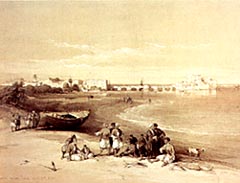 View of Sidon (19th century engraving) |
Like
other
Phoenician
city
states,
Sidon
suffered
from
a
succession
of
conquerors. At the end of the Persian era in 351 B.C., unable to resist the superior forces of Artaxerxes III, the desperate Sidonians locked their gates and set fire to their city rather than to submit to the invader. More than 40,000 died in the conflagration. After the disaster the city was too weak to oppose the triumphal march of Alexander the Great in 333 B.C. It sued for peace and the Hellenistic age of Sidon began. Under the successors of Alexander, Sidon, |
When Sidon, like the other cities of Phoenicia, fell under Roman domination, it continued to mint its own silver coins. The Romans also built a theater and other major monuments in the city. During the Byzantine period when the great earthquake of 551 A.D. destroyed most of the cities of Phoenicia, Beirut's school of Law took refuge in Sidon. The town continued quietly for the next century, until it was conquered by the Moslems in 636.
In 1111 Sidon was besieged and stormed by the Crusader Baldwin, who was soon to become King of Jerusalem. Under Frankish rule, the city became the chief town of the Seigniory of Sagette and the second and the four baronies of the Kingdom of Jerusalem.
Jerusalem surrendered to Saladin in 1187, but it was re-occupied for a hundred years when the Crusader Templars recaptured it briefly. They abandoned it for good in 1291, after the fall of Acre to the Mamluke forces.
In the 15th century, Sidon was one of the ports of Damascus and it flourished once more during the 17th century when it was rebuilt by Fakhreddine II, then ruler of Lebanon. Under his protection and encouragement, French merchants set up profitable business enterprises in Sidon for trade between France and Syria. By the beginning of the 19th century, however , Sidon was relatively obscure and remained so until the mid-20th century when it developed into an important commercial and agricultural center.
Archaelogical
Excavations
Early
French
excavations
led
by
Ernest
Renan
in
the
late
19th
century
uncovered
the
large
necropolis
of
Magharat
Abloun
outside
the
city.
The
royal
necropoli
at
nearby
Ayaa
and
Ain
el-Helwe
were
found
shortly
thereafter.
In
1937
Middle
Bronze
Age
tombs
were
opened
in
several
mountain
villages
overlooking
Sidon
and
at
this
time
a
number
of
archaeological
surveys
were
conducted
in
and
around
the
city.
|
Sidon
Today The entrance to Sidon from the north is on a wide divided highway lined with palm trees. As you approach, the landmark Crusader Sea Castle and modern port installations are immediately visible. The busy main street is full of small shops of every kind, including patisseries, whose oriental delicacies are stacked in little pyramids. Sidon is famous for a variety of local sweets which you can watch being made in the old souk or in shops on the main street. |
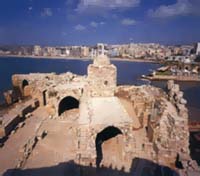 |
|
|
The
particular
specialty
of
Sidon
is
known
as
"senioura,"
a
delicious
crumbly
cookie. A growing city with a modern seaport, Sidon is the South's commercial and financial center. In prewar days it was a terminal and a refinery for Tapline, and now its huge storage tanks are used for the import and local distribution of fuel. The commercial port, the third largest in Lebanon, accommodates small freighters. Sidon is also the seat of government for South Lebanon. |
||
|
V
I
S
I
T
I
N
G
T
H
E
S
I
T
E
S The old section of modern Sidon developed at the end of the Crusader period. Here the visitor will enjoy wandering along the sea front to the Crusader Sea Castle, and looking around the old souks, “khans” (caravansaries) and other medieval remnants. |
||
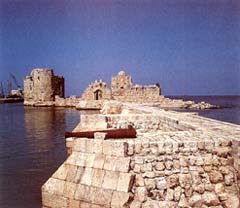 The Sea Castle |
1
-
The
Sea
Castle Is a fortress built by the Crusaders in the early 13th century on a small island connected to the mainland by a causeway. A climb to the top leads to the roof where there is a good view of the port and the old part of the city. Today the castle consists primarily of two towers connected by a wall. In the outer walls Roman columns were used as horizontal reinforcements, a feature often seen in fortifications built on or near former Roman sites. The west tower is the better preserved of the two. |
|
| Old prints of the fortress show it to be one of great beauty, but little remains of the embellishments that once decorated its ramparts. After the fall of Acre to the Mamlukes all the sea castles were destroyed to prevent the Crusaders from re-establishing footholds on the coast. | ||
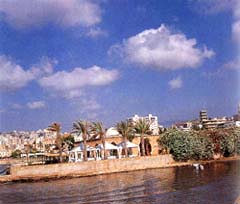 Resthouse |
2
-
A
government
Resthouse
on
the
waterfront
next
to
the
castle
offers
good
food
and
refreshment.
Situated
in
a
restored
medieval
building,
the
Resthouse
is
set
in
a
landscaped
seaside
terrace. The interior has vaulted ceilings and medieval decor. There is also a fine patio with a fountain. Open from noon until 4 PM and from 7 PM -12 PM. |
|
|
3
-
The
Souks Between the Sea Castle and the Castle of St. Louis stretches the old town. Not far from the Sea Castle is the picturesque vaulted souk of Sidon, where workmen still ply their trades. On the edge of the souk is a traditional coffee house where male clientele meet to smoke the narguileh (water pipe) and drink Turkish coffee. Fishermen sell their latest catch at the market near the port not far from the souk's entrance.
|
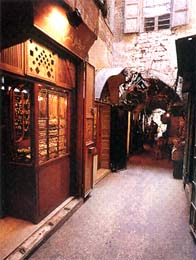 |
|
4
-
Khan
El
Franj The Khan El Franj is one of the many khans or caravansaries built by Fakhreddine II for merchants and goods. This is a typical khan with a large rectangular courtyard and a central fountain surrounded by covered galleries. The center of economic activity for the city in the 19th century, the khan also housed the French consulate. Today it is being renovated to serve as Sidon's cultural center. |
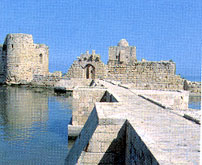 Khan El Franj |
|
|
5
-
The
Great
Mosque South of the souk on the way to the Castle of St. Louis, is the Great Mosque, formerly the Church of St. John of the Hospitalers. The four walls of this rectangular building (recently restored to their natural beauty) date to the 13th century. Originally a fortress-like Crusader compound with its own chapel, it is still an imposing structure, especially viewed from the seaside. |
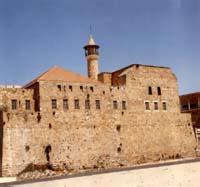 The Great Mosque |
The Castle of St. Louis was erected on the emplacement of a Fatimid fortress during the Crusade led by French King Louis IX, popularly known as St. Louis.
Built in the mid-13th century, the present state of the castle makes it easy to observe various stages of the restoration carried out in the Mamluke era, particularly work done in the 17th century by Emir Fakhreddine II. At the foot of the hill are a dozen or so Roman columns scattered on the ground.
7
-
Murex
Hill
To
the
south
of
the
citadel
is
a
mound
of
debris
called
Murex
Hill.
This
artificial
hill
(100
meters
long
and
50
meters
high)
was
formed
by
the
accumulation
of
refuse
from
the
purple
dye
factories
of
Phoenician
times.
Mosaic
tiling
found
at
the
top
of
the
mound
suggests
that
Roman
buildings
were
erected
there.
The
hill
today
is
covered
by
houses
and
buildings
as
well
as
a
cemetery.
Broken
murex
shells
can
still
be
seen
on
the
lower
part
of
the
hill,
but
because
of
extensive
construction,
it
is
increasingly
inaccessible
to
the
public.
8
-
Old
Ports
The
ancient
Egyptian
Port,
so
called
because
it
faced
south
towards
Egypt,
is
located
opposite
the
Castle
of
St.
Louis
and
Murex
Hill.
An
active
harbor
in
Phoenician
times,
it
has
silted
up
over
the
centuries.
Today
the
north
channel
harbor
is
used
only
for
local
fishing
boats
because
Fakhreddine
filled
it
in
during
the
17th
century
to
deny
entry
to
the
Turkish
fleet.
What
remains
of
this
harbor
goes
back
to
the
Roman
era.
The
Necropoli
of
Sidon.
The
three
main
necropoli
of
Sidon
lie
beyond
the
ancient
city
limits
and
were
in
use
until
the
late
Roman
and
early
Christian
eras.
These
are
the
necropolis
of
Magharat
Abloun,
the
royal
necropolis
of
Ayaa
below
the
present
village
of
Helalie,
and
the
necropolis
of
Ain
el
Helwe
to
the
southeast.
Located
in
what
are
now
residential
areas,
no
excavations
are
in
progress
at
any
of
these
sites.
South
of
the
city
an
ancient
cemetery
known
as
Dekerman
was
used
until
this
century.
It
is
also
an
archaeological
site,
with
an
extensive
collection
of
objects,
mostly
sarcophagi
and
tombs
in
situ,
as
well
as
fragments,
inscriptions
and
sculptures.
A
number
of
circular
Chalcolithic
(4000
B.C.)
foundations
can
also
be
seen
here.
If
you
have
time
The
Temple
of
Eshmoun.
At
the
right
of
the
bridge
on
the
Awali
River
just
before
reaching
Sidon,
is
a
spot
known
as
"Bustan
el
Sheikh,"
site
of
the
Temple
of
Eshmoun.
This
important
monument
goes
back
to
the
Persian
period
(6th
century
B.C.)
when
Sidon
was
at
its
zenith.
As
the
god
of
healing,
Eshmoun
was
identified
with
Asklepios,
the
Greek
god
of
medical
arts.
Each
Phoenician
city
state
had
its
own
gods,
and
Eshmoun
was
one
of
the
favorite
of
Sidon
during
its
golden
age,
the
6th
and
the
5th
centuries
B.C.
Additions
were
made
to
the
temple
in
subsequent
eras
and
it
remained
a
sacred
shrine
and
place
of
pilgrimage
well
into
the
first
centuries
A.D.
(BEIRUT - BYBLOS - JEITA GROTTO - TRIPOLI - ZAHLÉ - BAALBECK)
(AANJAR - THE CEDARS - TYRE - BEITEDDINE)
EGYPT - SYRIA - JORDAN